Travels and Stories
by Michael Frye | May 19, 2024 | Light and Weather, Travels and Stories, Vision and Creativity
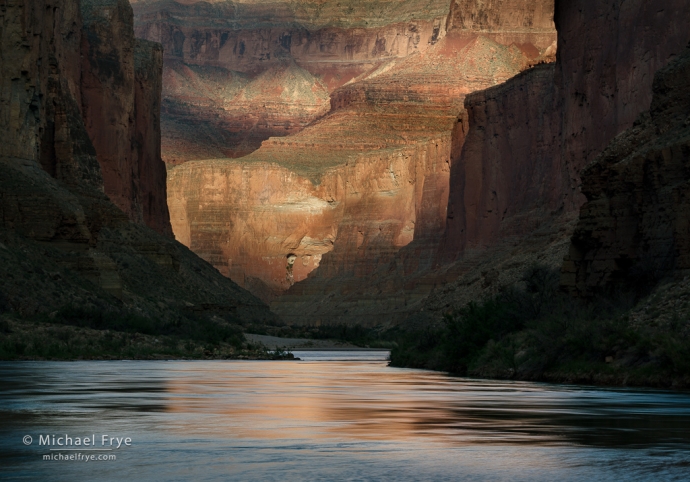
Dappled light above the Colorado River, Grand Canyon NP, Arizona. I used a neutral-density filter (probably seven stops) to slow the shutter speed to three seconds and smooth the water, and had to wait for moments when the wind was calm at the camera position, lest the wind vibrate the camera and blur the photo during the long exposure.
I left the Grand Canyon just a week ago. Once again I co-led a ten-day raft trip down the canyon with my friend Jerry Dodrill for Visionary Wild. And once again it was an amazing trip.
This journey is hard to describe if you haven’t experienced it. It’s more than just a photography trip – although the photography is fantastic. It’s a true wilderness adventure, immersed in the depths of this magnificent canyon for ten days, sleeping under the stars, living by the rhythm of the sun, moon, and river, sharing the experience with a small group of like-minded people. It’s unforgettable.
(more…)
by Michael Frye | Apr 21, 2024 | Travels and Stories
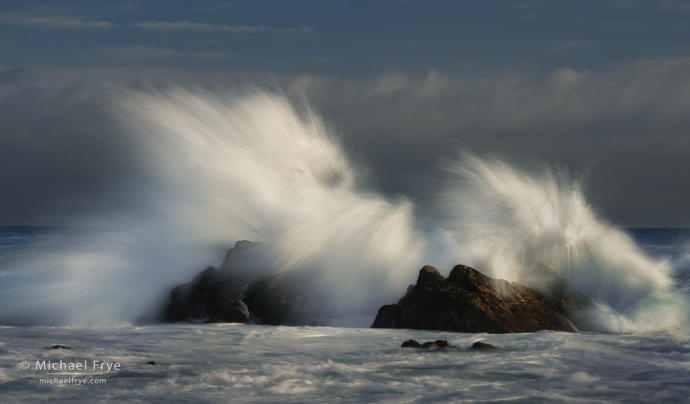
Crashing wave, Monterey Peninsula, California. I used a 1/2 second shutter speed to create some blur and sense of motion, while still preserving some of the shape and texture of the wave.
Because of our eclipse journey I haven’t had a chance to write about the Out of Big Sur conference yet – a big omission, because it was such a fun event! Great people, wonderful co-instructors, great locations, and well-organized by Chris Smith, Chrissy Donadi, and the rest of the Out of Chicago team.
We all had lots of fun photographing the Monterey Peninsula, Point Lobos, and the Big Sur Coast. Though I live fairly close to these areas, I’ve actually spent more time photographing coastal areas farther north near the northern-California redwoods, and along the Oregon Coast. So it was good to get re-acquainted with the Monterey and Big Sur region, and discover some new locations I hadn’t photographed before. It’s such a beautiful area.
(more…)
by Michael Frye | Apr 11, 2024 | Travels and Stories
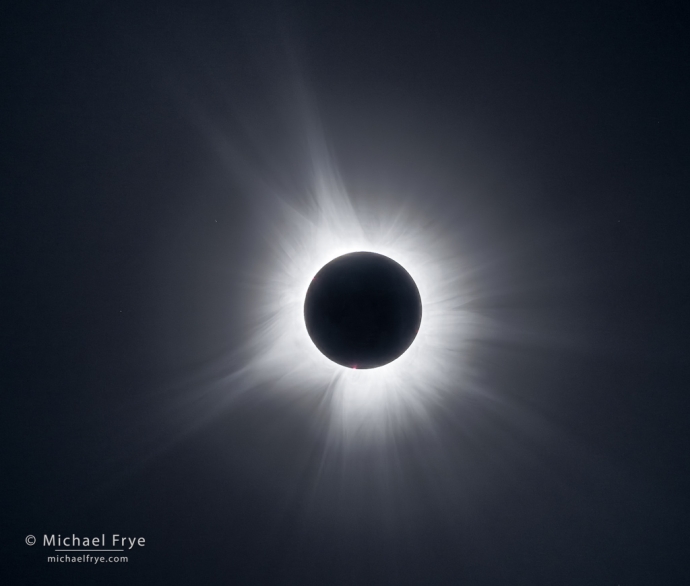
Total solar eclipse, April 8, 2024, northeast Arkansas
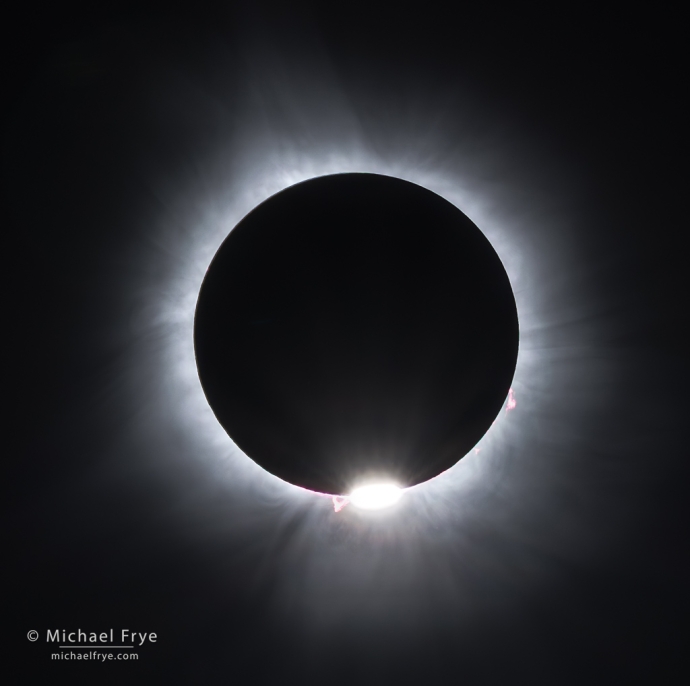
The “diamond ring” and solar flares as the sun emerges from a total solar eclipse, April 8, 2024, northeast Arkansas
I started thinking about the 2024 solar eclipse right after our last one in 2017. Claudia and I, along with our friend Robert Eckhardt, viewed that eclipse from the Sawtooth Mountains in Idaho, and it was such an amazing experience I immediately wanted to do it again.
When I looked at this 2024 eclipse, the best part was the length – four-and-a-half minutes of totality in Mexico and Texas, compared with only a little over two minutes in Idaho in 2017. Two minutes seemed way too short.
(more…)
by Michael Frye | Mar 31, 2024 | Light and Weather, Travels and Stories
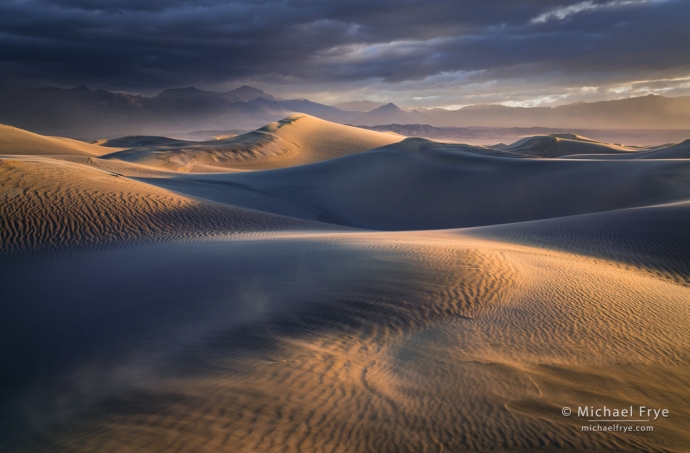
Dunes in a sandstorm at sunrise, Death Valley NP, California
Death Valley is a dynamic place. While the appearance of other landscapes frequently changes because of weather and seasonal changes, in Death Valley the land itself undergoes routine transformations caused by wind and water – especially the infrequent, but highly destructive, flash floods.
Last August Tropical Storm Hilary dumped over two inches of rain on Death Valley, washing out roads, closing the park for two months, and filling Badwater Basin with water – a resurrection of ancient Lake Manly. We visited Death Valley in late December, and got to see and photograph that lake, though it was shallower by then. (You can see some of my photos from that trip toward the bottom of my year-end-photos post.)
(more…)
by Michael Frye | Nov 5, 2023 | Travels and Stories
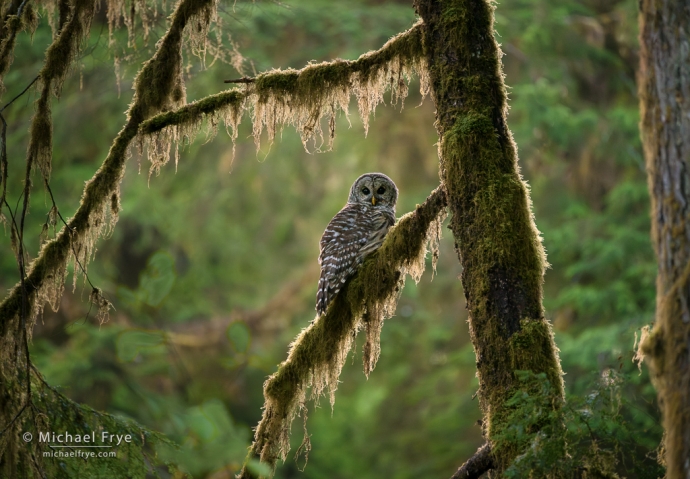
Barred owl, Olympic NP, Washington
My previous two posts focused on autumn color on the Olympic Peninsula, but it’s a diverse and beautiful area, and I made many photographs that didn’t involve fall color. The forests are quite photogenic even without fall leaves, plus some of my favorite images from the trip were made along the coast. And one of the highlights of our trip was photographing a barred owl.
We found this owl while driving along a back road early one morning. The owl took off from a log next to the road and flew into a nearby tree. I didn’t have my camera out, so we backed up to where the owl couldn’t see us. Then I stepped out of the car, grabbed my camera and 100-400mm lens, climbed into the passenger seat (the owl was on the right), and got everything set.
(more…)
by Michael Frye | Nov 2, 2023 | Travels and Stories
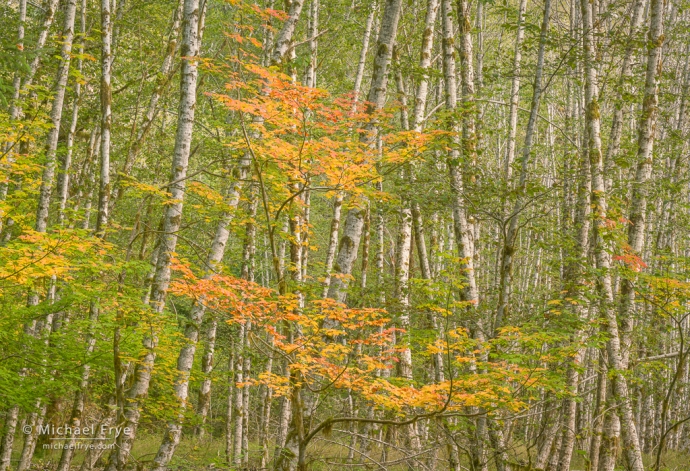
Vine maple and alders, autumn, Olympic NP, Washington
My previous post featured mostly images that combined fall color with the moss- and lichen-draped branches that Olympic National Park is known for. I like those juxtapositions, as they’re so characteristic of that area. But we found lots of other interesting juxtapositions as well.
One thing I kept looking for was groves of alders. Alders often form great patterns, with leaning, criss-crossing, light-colored trunks spotted with patches of moss or lichen. But while alders are deciduous trees, their leaves don’t turn color in the fall. Alders just drop their leaves while they’re still green. Even without that color, however, their patterns and structure make them worth photographing, and sometimes (like in the photo above) I was able to juxtapose maples with alder trunks. (Why don’t alder leaves turn color? No one really knows, but here’s one possible explanation.)
(more…)















